1809NRS Effective Nursing Practices Essay: Influenza and Care
VerifiedAdded on 2022/09/29
|11
|2459
|36
Essay
AI Summary
This essay addresses the case of Mr. Jimmy Holden, a 68-year-old resident of a residential aged care facility diagnosed with influenza and a chest infection. It begins by defining influenza, detailing its modes of spread, and outlining the specific risks it poses for older adults, such as weakened immune systems and complications like pneumonia and chronic conditions. The essay then explores infection control precautions, including hand hygiene, personal protective equipment (PPE), and cleaning/disinfection protocols, emphasizing their importance in preventing the spread of infection within the facility. It further delves into assessment and nursing care, covering pressure injury assessment, fluid balance charts, clinical assessments, and home hazard assessments, as well as the importance of cultural aspects of care. Finally, the essay discusses the involvement of interdisciplinary teams, including clinical leaders and support service providers, in providing comprehensive care for Mr. Holden. The essay concludes by summarizing the key points, reinforcing the need for effective nursing practices to manage influenza and improve patient outcomes.
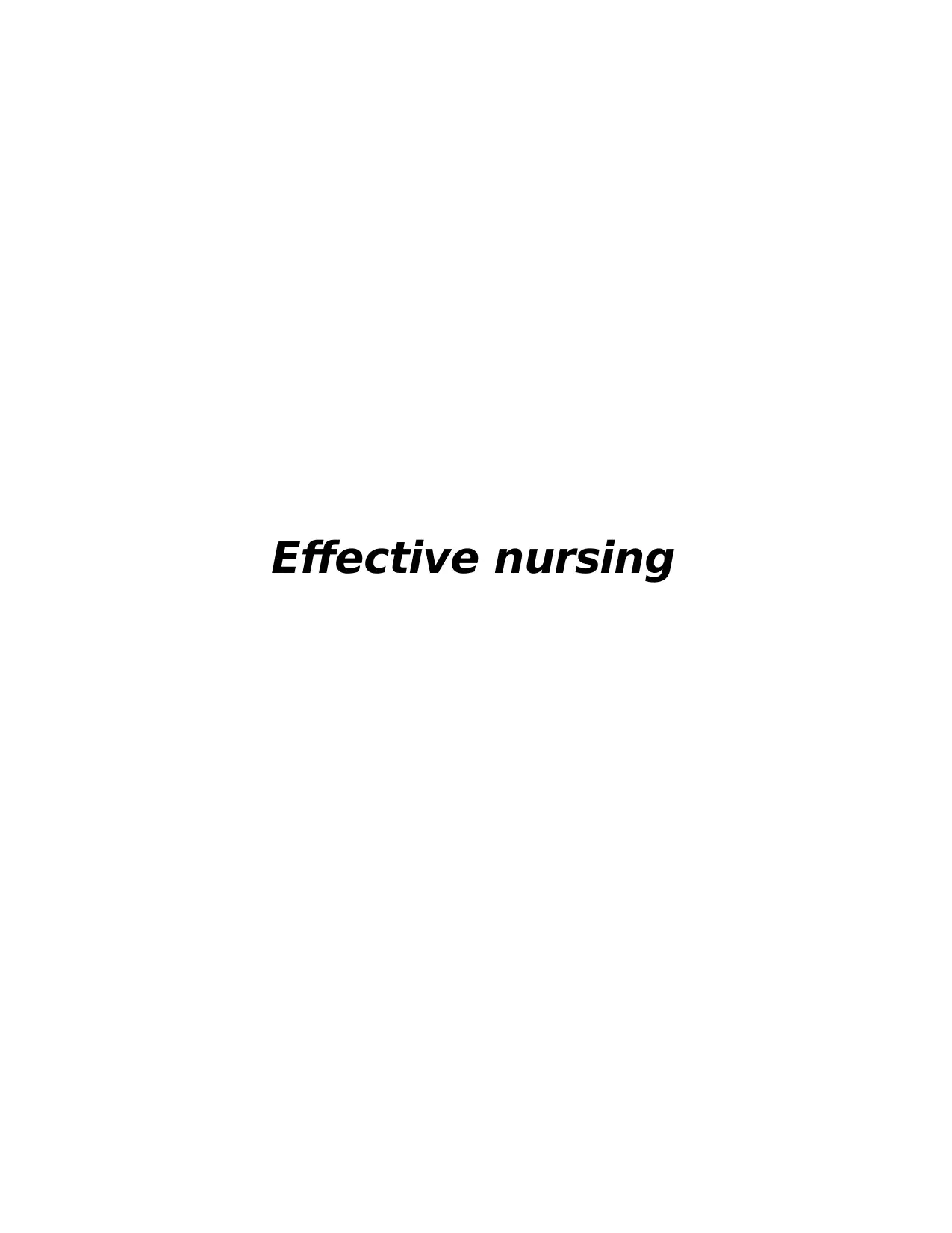
Effective nursing
Paraphrase This Document
Need a fresh take? Get an instant paraphrase of this document with our AI Paraphraser
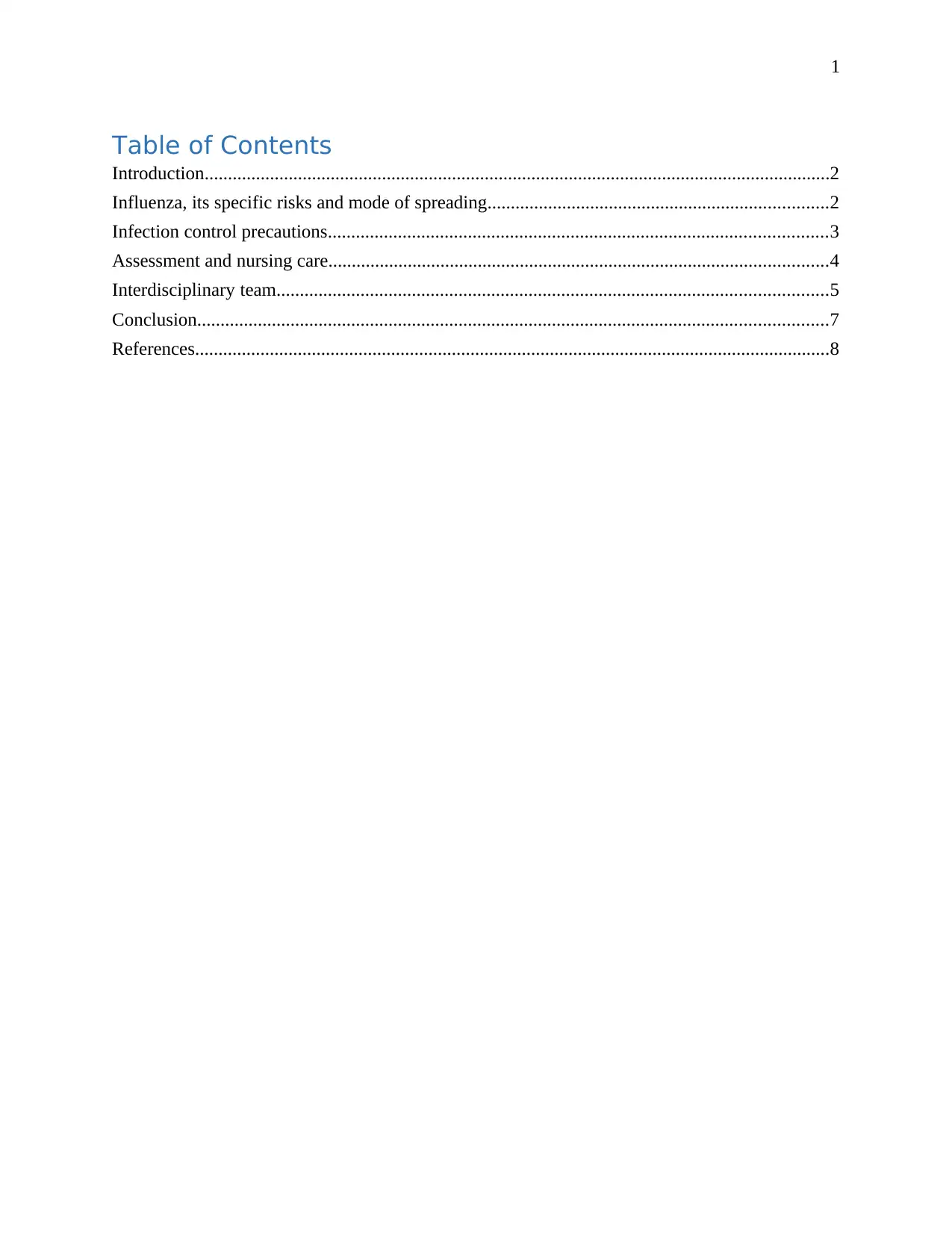
1
Table of Contents
Introduction......................................................................................................................................2
Influenza, its specific risks and mode of spreading.........................................................................2
Infection control precautions...........................................................................................................3
Assessment and nursing care...........................................................................................................4
Interdisciplinary team......................................................................................................................5
Conclusion.......................................................................................................................................7
References........................................................................................................................................8
Table of Contents
Introduction......................................................................................................................................2
Influenza, its specific risks and mode of spreading.........................................................................2
Infection control precautions...........................................................................................................3
Assessment and nursing care...........................................................................................................4
Interdisciplinary team......................................................................................................................5
Conclusion.......................................................................................................................................7
References........................................................................................................................................8
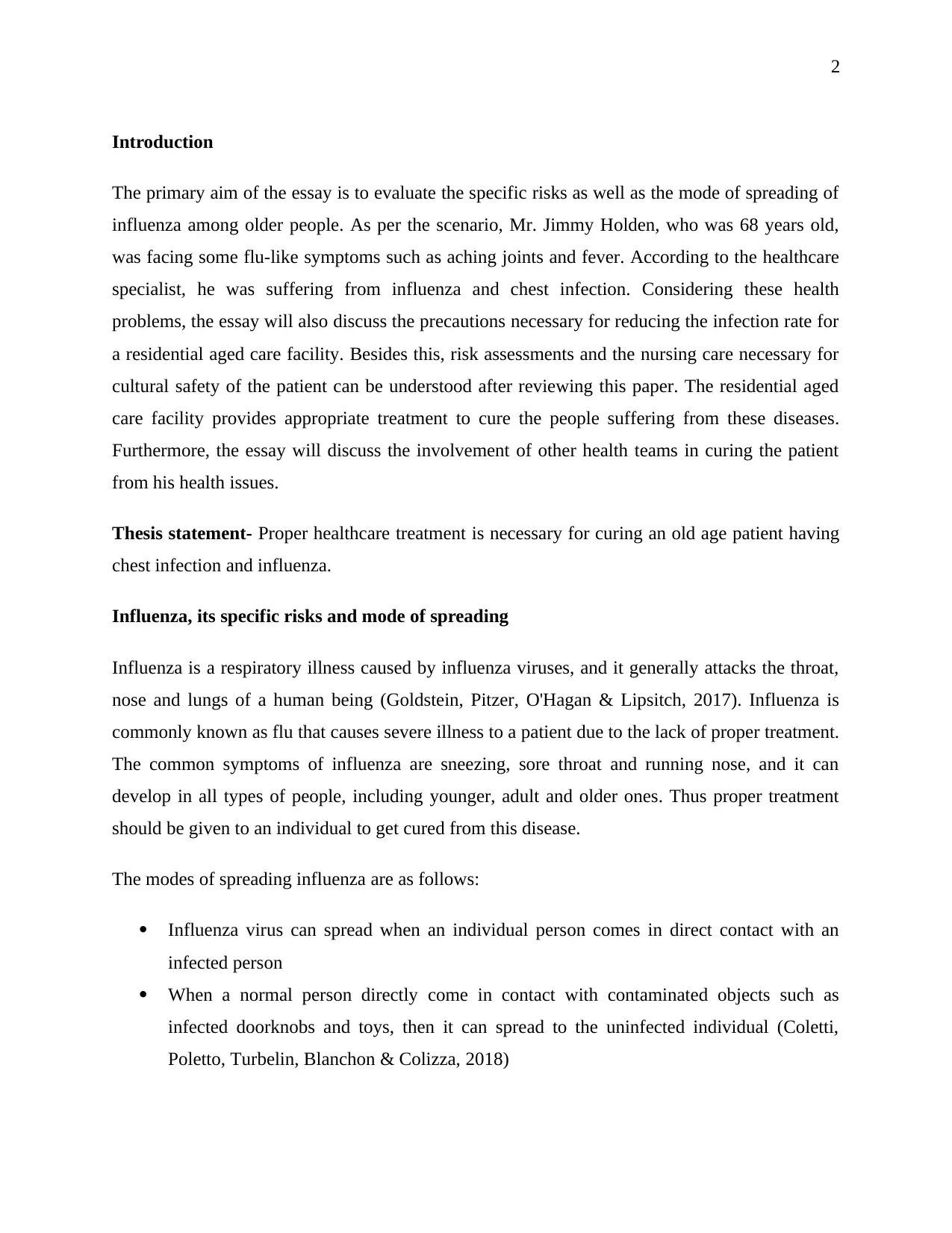
2
Introduction
The primary aim of the essay is to evaluate the specific risks as well as the mode of spreading of
influenza among older people. As per the scenario, Mr. Jimmy Holden, who was 68 years old,
was facing some flu-like symptoms such as aching joints and fever. According to the healthcare
specialist, he was suffering from influenza and chest infection. Considering these health
problems, the essay will also discuss the precautions necessary for reducing the infection rate for
a residential aged care facility. Besides this, risk assessments and the nursing care necessary for
cultural safety of the patient can be understood after reviewing this paper. The residential aged
care facility provides appropriate treatment to cure the people suffering from these diseases.
Furthermore, the essay will discuss the involvement of other health teams in curing the patient
from his health issues.
Thesis statement- Proper healthcare treatment is necessary for curing an old age patient having
chest infection and influenza.
Influenza, its specific risks and mode of spreading
Influenza is a respiratory illness caused by influenza viruses, and it generally attacks the throat,
nose and lungs of a human being (Goldstein, Pitzer, O'Hagan & Lipsitch, 2017). Influenza is
commonly known as flu that causes severe illness to a patient due to the lack of proper treatment.
The common symptoms of influenza are sneezing, sore throat and running nose, and it can
develop in all types of people, including younger, adult and older ones. Thus proper treatment
should be given to an individual to get cured from this disease.
The modes of spreading influenza are as follows:
Influenza virus can spread when an individual person comes in direct contact with an
infected person
When a normal person directly come in contact with contaminated objects such as
infected doorknobs and toys, then it can spread to the uninfected individual (Coletti,
Poletto, Turbelin, Blanchon & Colizza, 2018)
Introduction
The primary aim of the essay is to evaluate the specific risks as well as the mode of spreading of
influenza among older people. As per the scenario, Mr. Jimmy Holden, who was 68 years old,
was facing some flu-like symptoms such as aching joints and fever. According to the healthcare
specialist, he was suffering from influenza and chest infection. Considering these health
problems, the essay will also discuss the precautions necessary for reducing the infection rate for
a residential aged care facility. Besides this, risk assessments and the nursing care necessary for
cultural safety of the patient can be understood after reviewing this paper. The residential aged
care facility provides appropriate treatment to cure the people suffering from these diseases.
Furthermore, the essay will discuss the involvement of other health teams in curing the patient
from his health issues.
Thesis statement- Proper healthcare treatment is necessary for curing an old age patient having
chest infection and influenza.
Influenza, its specific risks and mode of spreading
Influenza is a respiratory illness caused by influenza viruses, and it generally attacks the throat,
nose and lungs of a human being (Goldstein, Pitzer, O'Hagan & Lipsitch, 2017). Influenza is
commonly known as flu that causes severe illness to a patient due to the lack of proper treatment.
The common symptoms of influenza are sneezing, sore throat and running nose, and it can
develop in all types of people, including younger, adult and older ones. Thus proper treatment
should be given to an individual to get cured from this disease.
The modes of spreading influenza are as follows:
Influenza virus can spread when an individual person comes in direct contact with an
infected person
When a normal person directly come in contact with contaminated objects such as
infected doorknobs and toys, then it can spread to the uninfected individual (Coletti,
Poletto, Turbelin, Blanchon & Colizza, 2018)
⊘ This is a preview!⊘
Do you want full access?
Subscribe today to unlock all pages.

Trusted by 1+ million students worldwide
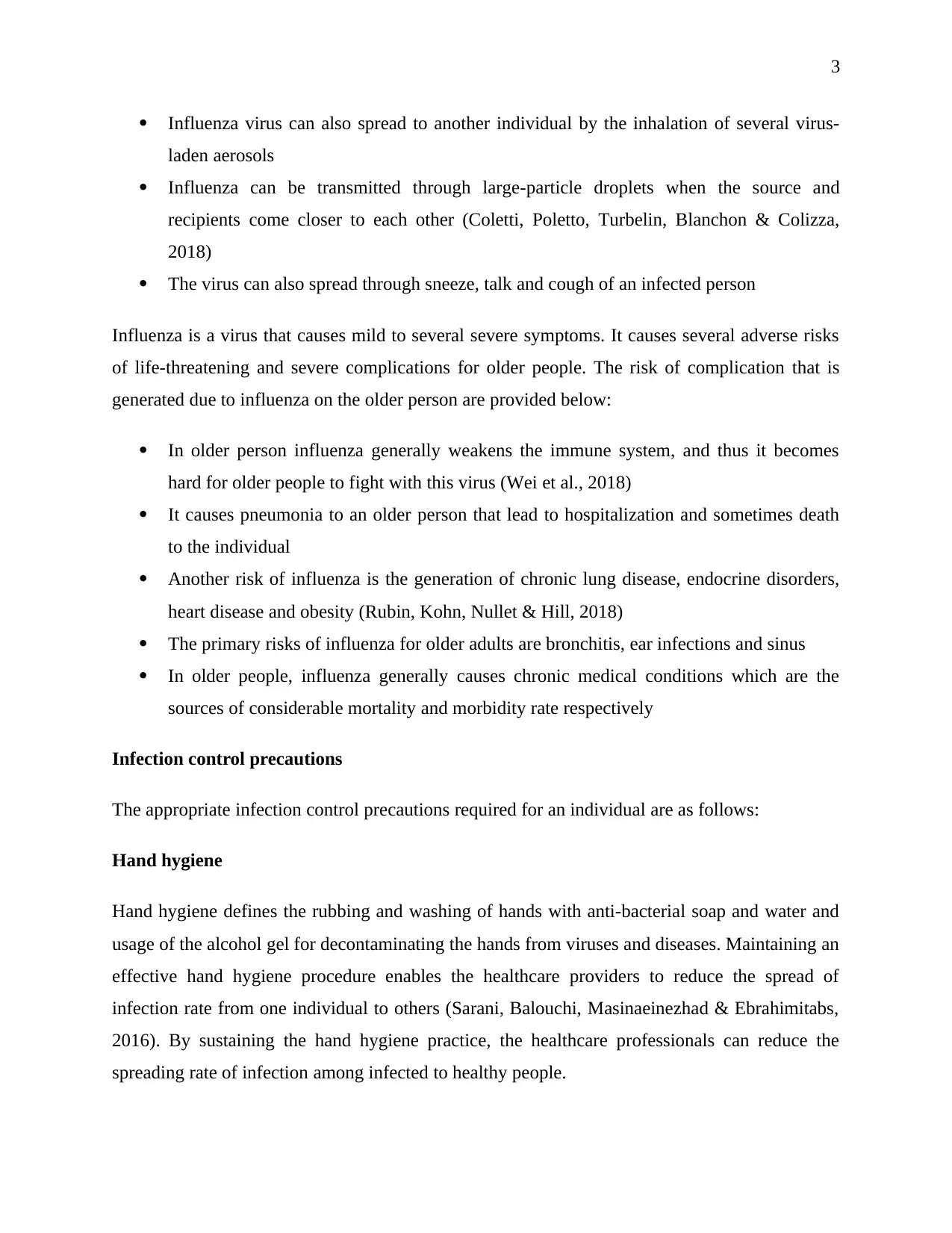
3
Influenza virus can also spread to another individual by the inhalation of several virus-
laden aerosols
Influenza can be transmitted through large-particle droplets when the source and
recipients come closer to each other (Coletti, Poletto, Turbelin, Blanchon & Colizza,
2018)
The virus can also spread through sneeze, talk and cough of an infected person
Influenza is a virus that causes mild to several severe symptoms. It causes several adverse risks
of life-threatening and severe complications for older people. The risk of complication that is
generated due to influenza on the older person are provided below:
In older person influenza generally weakens the immune system, and thus it becomes
hard for older people to fight with this virus (Wei et al., 2018)
It causes pneumonia to an older person that lead to hospitalization and sometimes death
to the individual
Another risk of influenza is the generation of chronic lung disease, endocrine disorders,
heart disease and obesity (Rubin, Kohn, Nullet & Hill, 2018)
The primary risks of influenza for older adults are bronchitis, ear infections and sinus
In older people, influenza generally causes chronic medical conditions which are the
sources of considerable mortality and morbidity rate respectively
Infection control precautions
The appropriate infection control precautions required for an individual are as follows:
Hand hygiene
Hand hygiene defines the rubbing and washing of hands with anti-bacterial soap and water and
usage of the alcohol gel for decontaminating the hands from viruses and diseases. Maintaining an
effective hand hygiene procedure enables the healthcare providers to reduce the spread of
infection rate from one individual to others (Sarani, Balouchi, Masinaeinezhad & Ebrahimitabs,
2016). By sustaining the hand hygiene practice, the healthcare professionals can reduce the
spreading rate of infection among infected to healthy people.
Influenza virus can also spread to another individual by the inhalation of several virus-
laden aerosols
Influenza can be transmitted through large-particle droplets when the source and
recipients come closer to each other (Coletti, Poletto, Turbelin, Blanchon & Colizza,
2018)
The virus can also spread through sneeze, talk and cough of an infected person
Influenza is a virus that causes mild to several severe symptoms. It causes several adverse risks
of life-threatening and severe complications for older people. The risk of complication that is
generated due to influenza on the older person are provided below:
In older person influenza generally weakens the immune system, and thus it becomes
hard for older people to fight with this virus (Wei et al., 2018)
It causes pneumonia to an older person that lead to hospitalization and sometimes death
to the individual
Another risk of influenza is the generation of chronic lung disease, endocrine disorders,
heart disease and obesity (Rubin, Kohn, Nullet & Hill, 2018)
The primary risks of influenza for older adults are bronchitis, ear infections and sinus
In older people, influenza generally causes chronic medical conditions which are the
sources of considerable mortality and morbidity rate respectively
Infection control precautions
The appropriate infection control precautions required for an individual are as follows:
Hand hygiene
Hand hygiene defines the rubbing and washing of hands with anti-bacterial soap and water and
usage of the alcohol gel for decontaminating the hands from viruses and diseases. Maintaining an
effective hand hygiene procedure enables the healthcare providers to reduce the spread of
infection rate from one individual to others (Sarani, Balouchi, Masinaeinezhad & Ebrahimitabs,
2016). By sustaining the hand hygiene practice, the healthcare professionals can reduce the
spreading rate of infection among infected to healthy people.
Paraphrase This Document
Need a fresh take? Get an instant paraphrase of this document with our AI Paraphraser

4
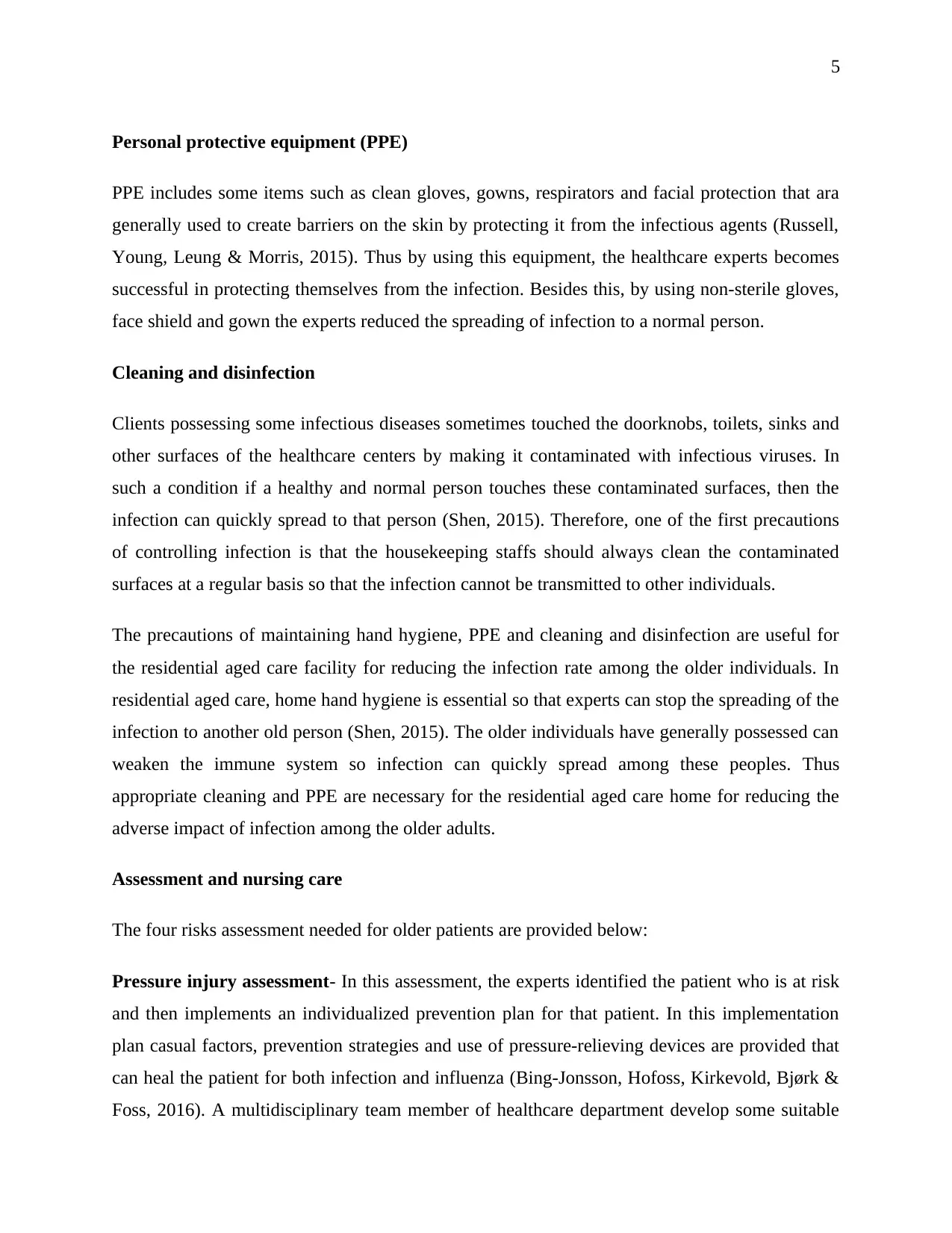
5
Personal protective equipment (PPE)
PPE includes some items such as clean gloves, gowns, respirators and facial protection that ara
generally used to create barriers on the skin by protecting it from the infectious agents (Russell,
Young, Leung & Morris, 2015). Thus by using this equipment, the healthcare experts becomes
successful in protecting themselves from the infection. Besides this, by using non-sterile gloves,
face shield and gown the experts reduced the spreading of infection to a normal person.
Cleaning and disinfection
Clients possessing some infectious diseases sometimes touched the doorknobs, toilets, sinks and
other surfaces of the healthcare centers by making it contaminated with infectious viruses. In
such a condition if a healthy and normal person touches these contaminated surfaces, then the
infection can quickly spread to that person (Shen, 2015). Therefore, one of the first precautions
of controlling infection is that the housekeeping staffs should always clean the contaminated
surfaces at a regular basis so that the infection cannot be transmitted to other individuals.
The precautions of maintaining hand hygiene, PPE and cleaning and disinfection are useful for
the residential aged care facility for reducing the infection rate among the older individuals. In
residential aged care, home hand hygiene is essential so that experts can stop the spreading of the
infection to another old person (Shen, 2015). The older individuals have generally possessed can
weaken the immune system so infection can quickly spread among these peoples. Thus
appropriate cleaning and PPE are necessary for the residential aged care home for reducing the
adverse impact of infection among the older adults.
Assessment and nursing care
The four risks assessment needed for older patients are provided below:
Pressure injury assessment- In this assessment, the experts identified the patient who is at risk
and then implements an individualized prevention plan for that patient. In this implementation
plan casual factors, prevention strategies and use of pressure-relieving devices are provided that
can heal the patient for both infection and influenza (Bing-Jonsson, Hofoss, Kirkevold, Bjørk &
Foss, 2016). A multidisciplinary team member of healthcare department develop some suitable
Personal protective equipment (PPE)
PPE includes some items such as clean gloves, gowns, respirators and facial protection that ara
generally used to create barriers on the skin by protecting it from the infectious agents (Russell,
Young, Leung & Morris, 2015). Thus by using this equipment, the healthcare experts becomes
successful in protecting themselves from the infection. Besides this, by using non-sterile gloves,
face shield and gown the experts reduced the spreading of infection to a normal person.
Cleaning and disinfection
Clients possessing some infectious diseases sometimes touched the doorknobs, toilets, sinks and
other surfaces of the healthcare centers by making it contaminated with infectious viruses. In
such a condition if a healthy and normal person touches these contaminated surfaces, then the
infection can quickly spread to that person (Shen, 2015). Therefore, one of the first precautions
of controlling infection is that the housekeeping staffs should always clean the contaminated
surfaces at a regular basis so that the infection cannot be transmitted to other individuals.
The precautions of maintaining hand hygiene, PPE and cleaning and disinfection are useful for
the residential aged care facility for reducing the infection rate among the older individuals. In
residential aged care, home hand hygiene is essential so that experts can stop the spreading of the
infection to another old person (Shen, 2015). The older individuals have generally possessed can
weaken the immune system so infection can quickly spread among these peoples. Thus
appropriate cleaning and PPE are necessary for the residential aged care home for reducing the
adverse impact of infection among the older adults.
Assessment and nursing care
The four risks assessment needed for older patients are provided below:
Pressure injury assessment- In this assessment, the experts identified the patient who is at risk
and then implements an individualized prevention plan for that patient. In this implementation
plan casual factors, prevention strategies and use of pressure-relieving devices are provided that
can heal the patient for both infection and influenza (Bing-Jonsson, Hofoss, Kirkevold, Bjørk &
Foss, 2016). A multidisciplinary team member of healthcare department develop some suitable
⊘ This is a preview!⊘
Do you want full access?
Subscribe today to unlock all pages.

Trusted by 1+ million students worldwide
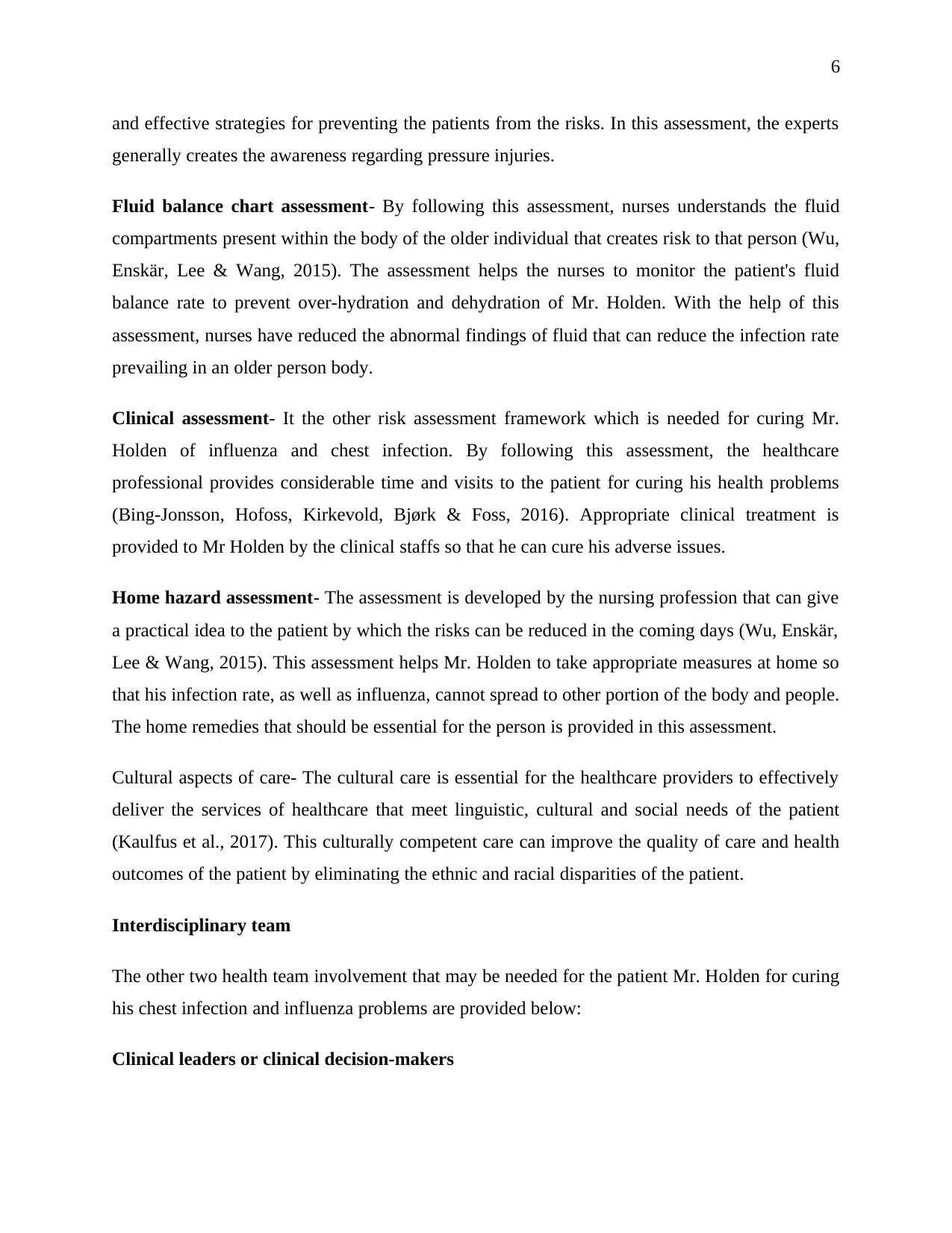
6
and effective strategies for preventing the patients from the risks. In this assessment, the experts
generally creates the awareness regarding pressure injuries.
Fluid balance chart assessment- By following this assessment, nurses understands the fluid
compartments present within the body of the older individual that creates risk to that person (Wu,
Enskär, Lee & Wang, 2015). The assessment helps the nurses to monitor the patient's fluid
balance rate to prevent over-hydration and dehydration of Mr. Holden. With the help of this
assessment, nurses have reduced the abnormal findings of fluid that can reduce the infection rate
prevailing in an older person body.
Clinical assessment- It the other risk assessment framework which is needed for curing Mr.
Holden of influenza and chest infection. By following this assessment, the healthcare
professional provides considerable time and visits to the patient for curing his health problems
(Bing-Jonsson, Hofoss, Kirkevold, Bjørk & Foss, 2016). Appropriate clinical treatment is
provided to Mr Holden by the clinical staffs so that he can cure his adverse issues.
Home hazard assessment- The assessment is developed by the nursing profession that can give
a practical idea to the patient by which the risks can be reduced in the coming days (Wu, Enskär,
Lee & Wang, 2015). This assessment helps Mr. Holden to take appropriate measures at home so
that his infection rate, as well as influenza, cannot spread to other portion of the body and people.
The home remedies that should be essential for the person is provided in this assessment.
Cultural aspects of care- The cultural care is essential for the healthcare providers to effectively
deliver the services of healthcare that meet linguistic, cultural and social needs of the patient
(Kaulfus et al., 2017). This culturally competent care can improve the quality of care and health
outcomes of the patient by eliminating the ethnic and racial disparities of the patient.
Interdisciplinary team
The other two health team involvement that may be needed for the patient Mr. Holden for curing
his chest infection and influenza problems are provided below:
Clinical leaders or clinical decision-makers
and effective strategies for preventing the patients from the risks. In this assessment, the experts
generally creates the awareness regarding pressure injuries.
Fluid balance chart assessment- By following this assessment, nurses understands the fluid
compartments present within the body of the older individual that creates risk to that person (Wu,
Enskär, Lee & Wang, 2015). The assessment helps the nurses to monitor the patient's fluid
balance rate to prevent over-hydration and dehydration of Mr. Holden. With the help of this
assessment, nurses have reduced the abnormal findings of fluid that can reduce the infection rate
prevailing in an older person body.
Clinical assessment- It the other risk assessment framework which is needed for curing Mr.
Holden of influenza and chest infection. By following this assessment, the healthcare
professional provides considerable time and visits to the patient for curing his health problems
(Bing-Jonsson, Hofoss, Kirkevold, Bjørk & Foss, 2016). Appropriate clinical treatment is
provided to Mr Holden by the clinical staffs so that he can cure his adverse issues.
Home hazard assessment- The assessment is developed by the nursing profession that can give
a practical idea to the patient by which the risks can be reduced in the coming days (Wu, Enskär,
Lee & Wang, 2015). This assessment helps Mr. Holden to take appropriate measures at home so
that his infection rate, as well as influenza, cannot spread to other portion of the body and people.
The home remedies that should be essential for the person is provided in this assessment.
Cultural aspects of care- The cultural care is essential for the healthcare providers to effectively
deliver the services of healthcare that meet linguistic, cultural and social needs of the patient
(Kaulfus et al., 2017). This culturally competent care can improve the quality of care and health
outcomes of the patient by eliminating the ethnic and racial disparities of the patient.
Interdisciplinary team
The other two health team involvement that may be needed for the patient Mr. Holden for curing
his chest infection and influenza problems are provided below:
Clinical leaders or clinical decision-makers
Paraphrase This Document
Need a fresh take? Get an instant paraphrase of this document with our AI Paraphraser
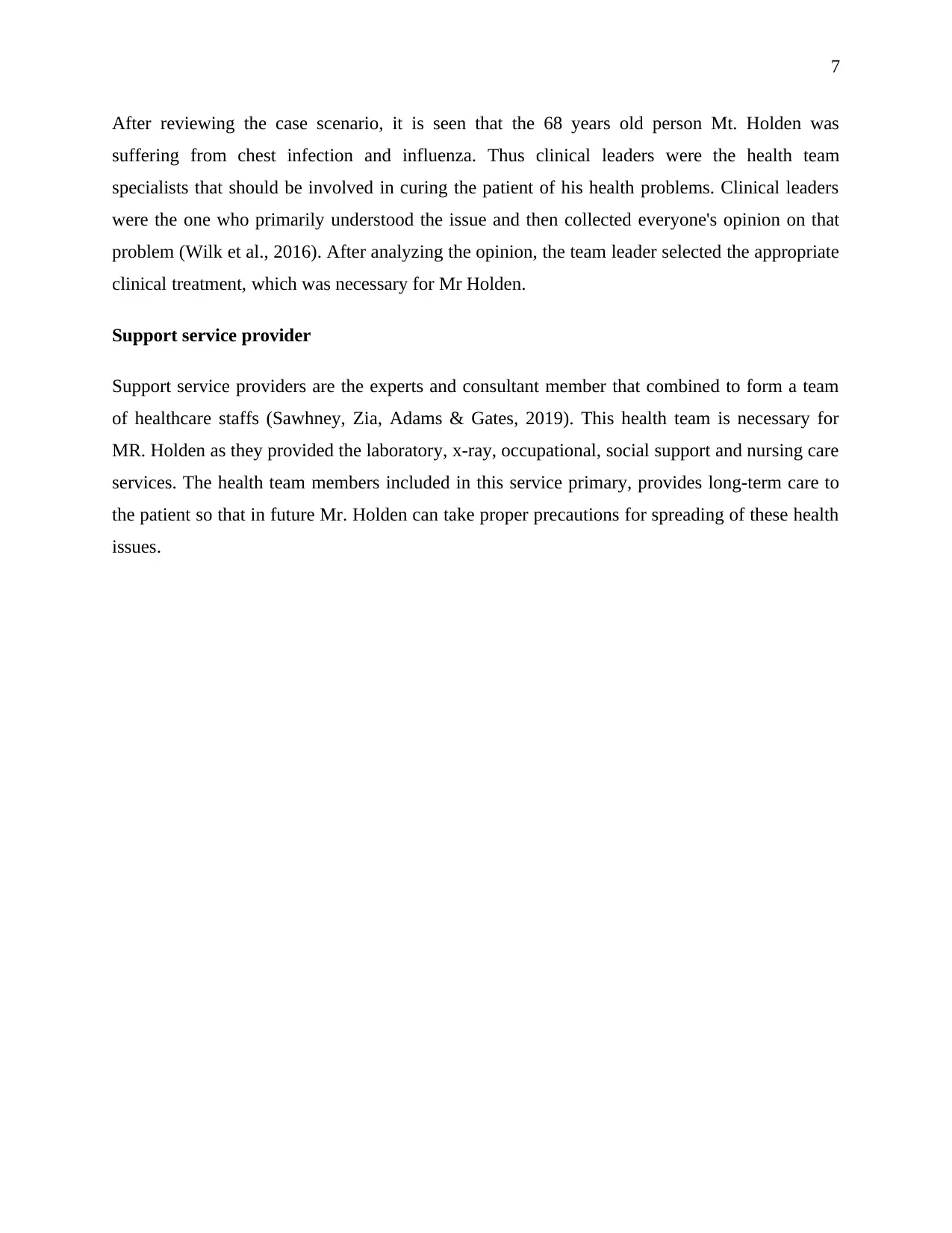
7
After reviewing the case scenario, it is seen that the 68 years old person Mt. Holden was
suffering from chest infection and influenza. Thus clinical leaders were the health team
specialists that should be involved in curing the patient of his health problems. Clinical leaders
were the one who primarily understood the issue and then collected everyone's opinion on that
problem (Wilk et al., 2016). After analyzing the opinion, the team leader selected the appropriate
clinical treatment, which was necessary for Mr Holden.
Support service provider
Support service providers are the experts and consultant member that combined to form a team
of healthcare staffs (Sawhney, Zia, Adams & Gates, 2019). This health team is necessary for
MR. Holden as they provided the laboratory, x-ray, occupational, social support and nursing care
services. The health team members included in this service primary, provides long-term care to
the patient so that in future Mr. Holden can take proper precautions for spreading of these health
issues.
After reviewing the case scenario, it is seen that the 68 years old person Mt. Holden was
suffering from chest infection and influenza. Thus clinical leaders were the health team
specialists that should be involved in curing the patient of his health problems. Clinical leaders
were the one who primarily understood the issue and then collected everyone's opinion on that
problem (Wilk et al., 2016). After analyzing the opinion, the team leader selected the appropriate
clinical treatment, which was necessary for Mr Holden.
Support service provider
Support service providers are the experts and consultant member that combined to form a team
of healthcare staffs (Sawhney, Zia, Adams & Gates, 2019). This health team is necessary for
MR. Holden as they provided the laboratory, x-ray, occupational, social support and nursing care
services. The health team members included in this service primary, provides long-term care to
the patient so that in future Mr. Holden can take proper precautions for spreading of these health
issues.
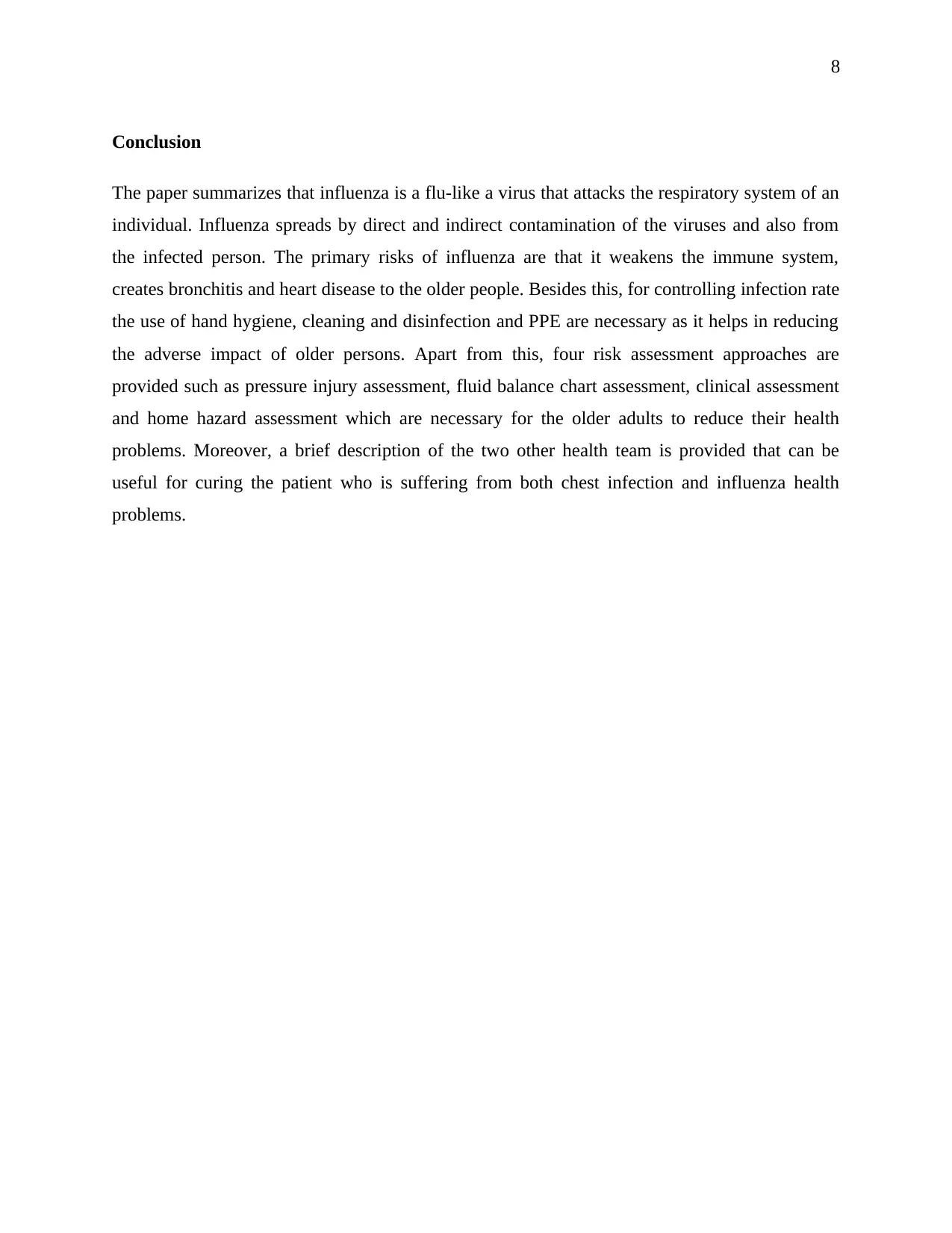
8
Conclusion
The paper summarizes that influenza is a flu-like a virus that attacks the respiratory system of an
individual. Influenza spreads by direct and indirect contamination of the viruses and also from
the infected person. The primary risks of influenza are that it weakens the immune system,
creates bronchitis and heart disease to the older people. Besides this, for controlling infection rate
the use of hand hygiene, cleaning and disinfection and PPE are necessary as it helps in reducing
the adverse impact of older persons. Apart from this, four risk assessment approaches are
provided such as pressure injury assessment, fluid balance chart assessment, clinical assessment
and home hazard assessment which are necessary for the older adults to reduce their health
problems. Moreover, a brief description of the two other health team is provided that can be
useful for curing the patient who is suffering from both chest infection and influenza health
problems.
Conclusion
The paper summarizes that influenza is a flu-like a virus that attacks the respiratory system of an
individual. Influenza spreads by direct and indirect contamination of the viruses and also from
the infected person. The primary risks of influenza are that it weakens the immune system,
creates bronchitis and heart disease to the older people. Besides this, for controlling infection rate
the use of hand hygiene, cleaning and disinfection and PPE are necessary as it helps in reducing
the adverse impact of older persons. Apart from this, four risk assessment approaches are
provided such as pressure injury assessment, fluid balance chart assessment, clinical assessment
and home hazard assessment which are necessary for the older adults to reduce their health
problems. Moreover, a brief description of the two other health team is provided that can be
useful for curing the patient who is suffering from both chest infection and influenza health
problems.
⊘ This is a preview!⊘
Do you want full access?
Subscribe today to unlock all pages.

Trusted by 1+ million students worldwide
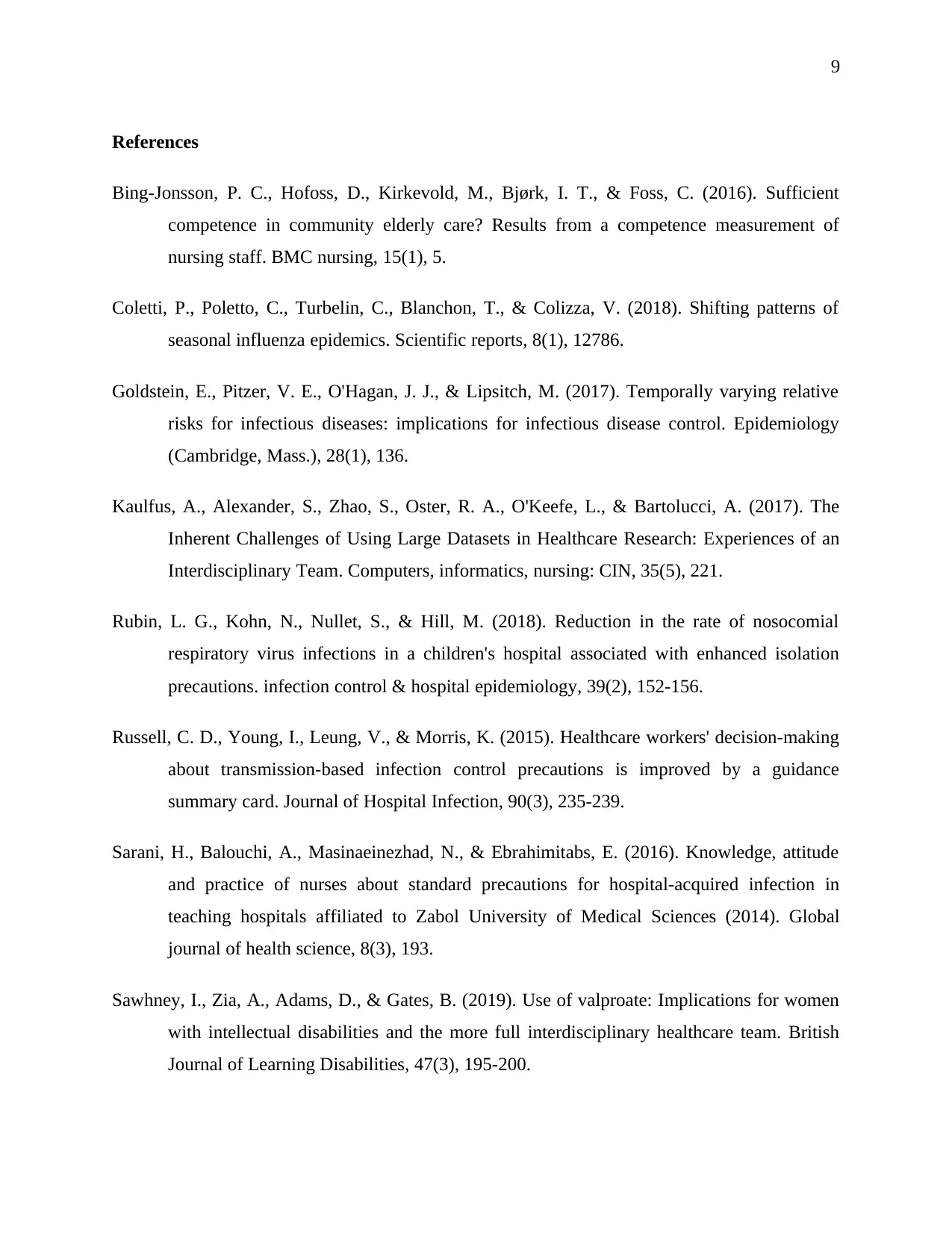
9
References
Bing-Jonsson, P. C., Hofoss, D., Kirkevold, M., Bjørk, I. T., & Foss, C. (2016). Sufficient
competence in community elderly care? Results from a competence measurement of
nursing staff. BMC nursing, 15(1), 5.
Coletti, P., Poletto, C., Turbelin, C., Blanchon, T., & Colizza, V. (2018). Shifting patterns of
seasonal influenza epidemics. Scientific reports, 8(1), 12786.
Goldstein, E., Pitzer, V. E., O'Hagan, J. J., & Lipsitch, M. (2017). Temporally varying relative
risks for infectious diseases: implications for infectious disease control. Epidemiology
(Cambridge, Mass.), 28(1), 136.
Kaulfus, A., Alexander, S., Zhao, S., Oster, R. A., O'Keefe, L., & Bartolucci, A. (2017). The
Inherent Challenges of Using Large Datasets in Healthcare Research: Experiences of an
Interdisciplinary Team. Computers, informatics, nursing: CIN, 35(5), 221.
Rubin, L. G., Kohn, N., Nullet, S., & Hill, M. (2018). Reduction in the rate of nosocomial
respiratory virus infections in a children's hospital associated with enhanced isolation
precautions. infection control & hospital epidemiology, 39(2), 152-156.
Russell, C. D., Young, I., Leung, V., & Morris, K. (2015). Healthcare workers' decision-making
about transmission-based infection control precautions is improved by a guidance
summary card. Journal of Hospital Infection, 90(3), 235-239.
Sarani, H., Balouchi, A., Masinaeinezhad, N., & Ebrahimitabs, E. (2016). Knowledge, attitude
and practice of nurses about standard precautions for hospital-acquired infection in
teaching hospitals affiliated to Zabol University of Medical Sciences (2014). Global
journal of health science, 8(3), 193.
Sawhney, I., Zia, A., Adams, D., & Gates, B. (2019). Use of valproate: Implications for women
with intellectual disabilities and the more full interdisciplinary healthcare team. British
Journal of Learning Disabilities, 47(3), 195-200.
References
Bing-Jonsson, P. C., Hofoss, D., Kirkevold, M., Bjørk, I. T., & Foss, C. (2016). Sufficient
competence in community elderly care? Results from a competence measurement of
nursing staff. BMC nursing, 15(1), 5.
Coletti, P., Poletto, C., Turbelin, C., Blanchon, T., & Colizza, V. (2018). Shifting patterns of
seasonal influenza epidemics. Scientific reports, 8(1), 12786.
Goldstein, E., Pitzer, V. E., O'Hagan, J. J., & Lipsitch, M. (2017). Temporally varying relative
risks for infectious diseases: implications for infectious disease control. Epidemiology
(Cambridge, Mass.), 28(1), 136.
Kaulfus, A., Alexander, S., Zhao, S., Oster, R. A., O'Keefe, L., & Bartolucci, A. (2017). The
Inherent Challenges of Using Large Datasets in Healthcare Research: Experiences of an
Interdisciplinary Team. Computers, informatics, nursing: CIN, 35(5), 221.
Rubin, L. G., Kohn, N., Nullet, S., & Hill, M. (2018). Reduction in the rate of nosocomial
respiratory virus infections in a children's hospital associated with enhanced isolation
precautions. infection control & hospital epidemiology, 39(2), 152-156.
Russell, C. D., Young, I., Leung, V., & Morris, K. (2015). Healthcare workers' decision-making
about transmission-based infection control precautions is improved by a guidance
summary card. Journal of Hospital Infection, 90(3), 235-239.
Sarani, H., Balouchi, A., Masinaeinezhad, N., & Ebrahimitabs, E. (2016). Knowledge, attitude
and practice of nurses about standard precautions for hospital-acquired infection in
teaching hospitals affiliated to Zabol University of Medical Sciences (2014). Global
journal of health science, 8(3), 193.
Sawhney, I., Zia, A., Adams, D., & Gates, B. (2019). Use of valproate: Implications for women
with intellectual disabilities and the more full interdisciplinary healthcare team. British
Journal of Learning Disabilities, 47(3), 195-200.
Paraphrase This Document
Need a fresh take? Get an instant paraphrase of this document with our AI Paraphraser
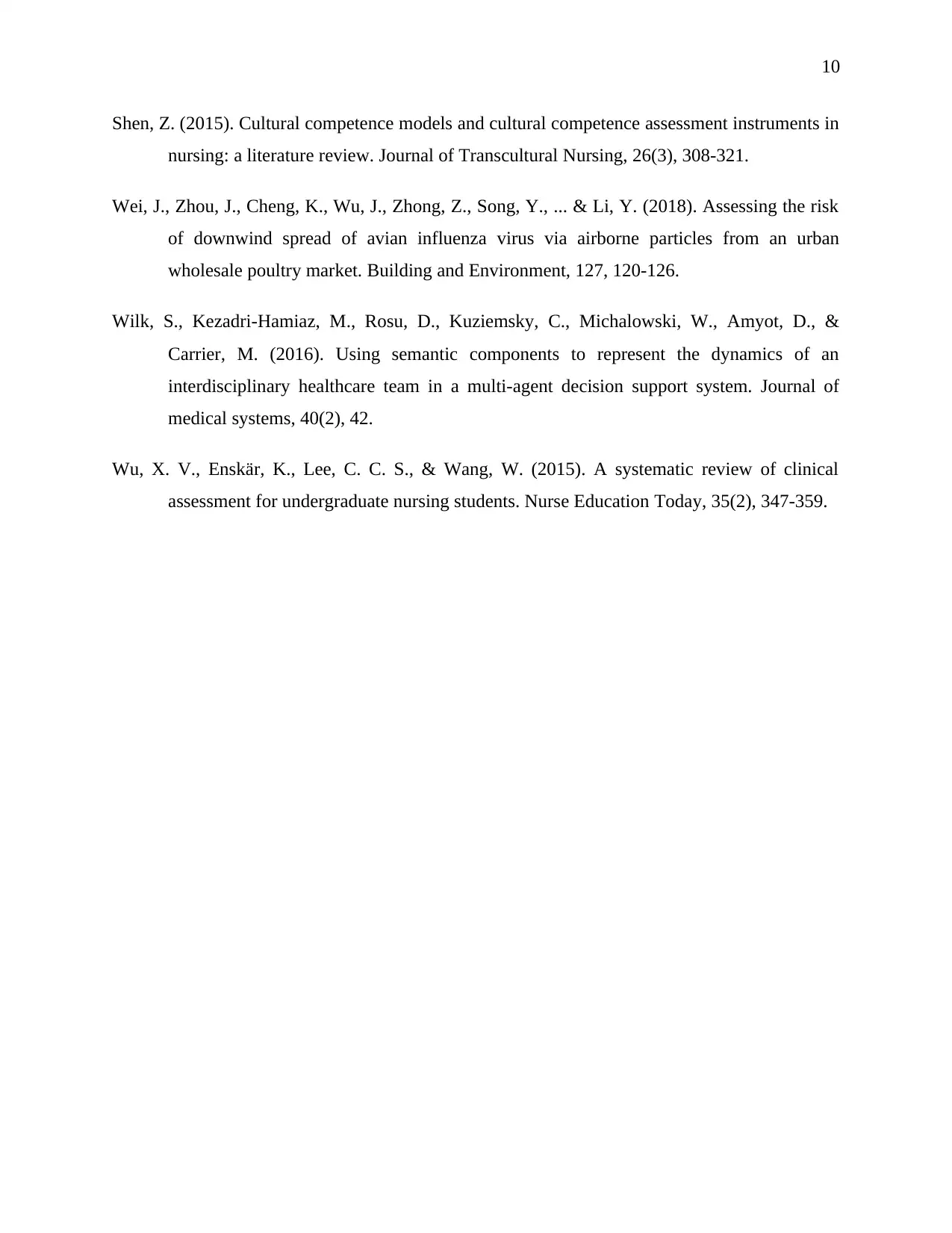
10
Shen, Z. (2015). Cultural competence models and cultural competence assessment instruments in
nursing: a literature review. Journal of Transcultural Nursing, 26(3), 308-321.
Wei, J., Zhou, J., Cheng, K., Wu, J., Zhong, Z., Song, Y., ... & Li, Y. (2018). Assessing the risk
of downwind spread of avian influenza virus via airborne particles from an urban
wholesale poultry market. Building and Environment, 127, 120-126.
Wilk, S., Kezadri-Hamiaz, M., Rosu, D., Kuziemsky, C., Michalowski, W., Amyot, D., &
Carrier, M. (2016). Using semantic components to represent the dynamics of an
interdisciplinary healthcare team in a multi-agent decision support system. Journal of
medical systems, 40(2), 42.
Wu, X. V., Enskär, K., Lee, C. C. S., & Wang, W. (2015). A systematic review of clinical
assessment for undergraduate nursing students. Nurse Education Today, 35(2), 347-359.
Shen, Z. (2015). Cultural competence models and cultural competence assessment instruments in
nursing: a literature review. Journal of Transcultural Nursing, 26(3), 308-321.
Wei, J., Zhou, J., Cheng, K., Wu, J., Zhong, Z., Song, Y., ... & Li, Y. (2018). Assessing the risk
of downwind spread of avian influenza virus via airborne particles from an urban
wholesale poultry market. Building and Environment, 127, 120-126.
Wilk, S., Kezadri-Hamiaz, M., Rosu, D., Kuziemsky, C., Michalowski, W., Amyot, D., &
Carrier, M. (2016). Using semantic components to represent the dynamics of an
interdisciplinary healthcare team in a multi-agent decision support system. Journal of
medical systems, 40(2), 42.
Wu, X. V., Enskär, K., Lee, C. C. S., & Wang, W. (2015). A systematic review of clinical
assessment for undergraduate nursing students. Nurse Education Today, 35(2), 347-359.
1 out of 11
Related Documents
Your All-in-One AI-Powered Toolkit for Academic Success.
+13062052269
info@desklib.com
Available 24*7 on WhatsApp / Email
![[object Object]](/_next/static/media/star-bottom.7253800d.svg)
Unlock your academic potential
Copyright © 2020–2025 A2Z Services. All Rights Reserved. Developed and managed by ZUCOL.





